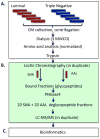Lectin chromatography/mass spectrometry discovery workflow identifies putative biomarkers of aggressive breast cancers
- PMID: 22309216
- PMCID: PMC3383053
- DOI: 10.1021/pr201206w
Lectin chromatography/mass spectrometry discovery workflow identifies putative biomarkers of aggressive breast cancers
Abstract
We used a lectin chromatography/MS-based approach to screen conditioned medium from a panel of luminal (less aggressive) and triple negative (more aggressive) breast cancer cell lines (n=5/subtype). The samples were fractionated using the lectins Aleuria aurantia (AAL) and Sambucus nigra agglutinin (SNA), which recognize fucose and sialic acid, respectively. The bound fractions were enzymatically N-deglycosylated and analyzed by LC-MS/MS. In total, we identified 533 glycoproteins, ∼90% of which were components of the cell surface or extracellular matrix. We observed 1011 glycosites, 100 of which were solely detected in ≥3 triple negative lines. Statistical analyses suggested that a number of these glycosites were triple negative-specific and thus potential biomarkers for this tumor subtype. An analysis of RNaseq data revealed that approximately half of the mRNAs encoding the protein scaffolds that carried potential biomarker glycosites were up-regulated in triple negative vs luminal cell lines, and that a number of genes encoding fucosyl- or sialyltransferases were differentially expressed between the two subtypes, suggesting that alterations in glycosylation may also drive candidate identification. Notably, the glycoproteins from which these putative biomarker candidates were derived are involved in cancer-related processes. Thus, they may represent novel therapeutic targets for this aggressive tumor subtype.
Figures






Similar articles
-
A lectin affinity workflow targeting glycosite-specific, cancer-related carbohydrate structures in trypsin-digested human plasma.Anal Biochem. 2011 Jan 1;408(1):71-85. doi: 10.1016/j.ab.2010.08.010. Epub 2010 Aug 10. Anal Biochem. 2011. PMID: 20705048 Free PMC article.
-
Elucidation of N-glycosites within human plasma glycoproteins for cancer biomarker discovery.Methods Mol Biol. 2013;951:307-22. doi: 10.1007/978-1-62703-146-2_21. Methods Mol Biol. 2013. PMID: 23296540
-
Differential proteomic approach for identification and verification of aberrantly glycosylated proteins in adenocarcinoma lung cancer (ADLC) plasmas by lectin-capturing and targeted mass spectrometry.J Proteomics. 2014 Jun 25;106:221-9. doi: 10.1016/j.jprot.2014.04.031. Epub 2014 Apr 26. J Proteomics. 2014. PMID: 24780727
-
Using lectins to harvest the plasma/serum glycoproteome.Electrophoresis. 2012 Jul;33(12):1746-54. doi: 10.1002/elps.201100567. Electrophoresis. 2012. PMID: 22740463 Review.
-
Lectin-based glycoproteomic techniques for the enrichment and identification of potential biomarkers.Methods Enzymol. 2010;480:461-76. doi: 10.1016/S0076-6879(10)80020-5. Methods Enzymol. 2010. PMID: 20816222 Review.
Cited by
-
Conditional ablation of heparan sulfate expression in stromal fibroblasts promotes tumor growth in vivo.PLoS One. 2023 Feb 21;18(2):e0281820. doi: 10.1371/journal.pone.0281820. eCollection 2023. PLoS One. 2023. PMID: 36809261 Free PMC article.
-
Pinellia pedatisecta agglutinin-based lectin blot analysis distinguishes between glycosylation patterns in various cancer cell lines.Oncol Lett. 2014 Aug;8(2):837-840. doi: 10.3892/ol.2014.2201. Epub 2014 May 30. Oncol Lett. 2014. PMID: 25013506 Free PMC article.
-
Comprehensive Transcriptomic Analysis Identifies ST8SIA1 as a Survival-Related Sialyltransferase Gene in Breast Cancer.Genes (Basel). 2020 Nov 28;11(12):1436. doi: 10.3390/genes11121436. Genes (Basel). 2020. PMID: 33260650 Free PMC article.
-
Marine Lectins DlFBL and HddSBL Fused with Soluble Coxsackie-Adenovirus Receptor Facilitate Adenovirus Infection in Cancer Cells BUT Have Different Effects on Cell Survival.Mar Drugs. 2017 Mar 14;15(3):73. doi: 10.3390/md15030073. Mar Drugs. 2017. PMID: 28335432 Free PMC article.
-
A peptide N-terminal protection strategy for comprehensive glycoproteome analysis using hydrazide chemistry based method.Sci Rep. 2015 May 11;5:10164. doi: 10.1038/srep10164. Sci Rep. 2015. PMID: 25959593 Free PMC article.
References
-
- Clowers BH, Dodds ED, Seipert RR, Lebrilla CB. Site determination of protein glycosylation based on digestion with immobilized nonspecific proteases and Fourier transform ion cyclotron resonance mass spectrometry. J Proteome Res. 2007;6(10):4032–40. - PubMed
-
- Duffy MJ, Evoy D, McDermott EW. CA 15–3: uses and limitation as a biomarker for breast cancer. Clin Chim Acta. 2010;411(23–24):1869–74. - PubMed
-
- Orntoft TF, Vestergaard EM. Clinical aspects of altered glycosylation of glycoproteins in cancer. Electrophoresis. 1999;20(2):362–71. - PubMed
Publication types
MeSH terms
Substances
Grants and funding
LinkOut - more resources
Full Text Sources
Medical
Research Materials

